Assessment of Xenoestrogens in Jordanian Water System: Activity and Identification
Abstract
1. Introduction
2. Materials and Methods
2.1. Chemicals
2.2. Sample Locations
2.3. Sample Collection
2.4. Sample Preparation
2.4.1. Water
2.4.2. Vegetables
2.5. Yeast Screening Assays
2.6. Data Analysis
2.7. LC-MS/MS Analysis
3. Results and Discussion
3.1. Study Area
3.2. Estrogenicity in Water Samples
3.2.1. Tap Samples
3.2.2. Surface Water
| Expected Compound | As-Samra | King Talal Dam | Almujeb Dam | King Abdullah Canal | Origin 3 | Ref. 2 | Chemical Structure 1 |
|---|---|---|---|---|---|---|---|
| 3 5 6-Trichloro-2-pyridinol (TCPy) | Yes | Yes | Yes | Yes | Pesticide | [104] |  |
| Isoferulic acid | Yes | - | - | - | Natural products | [105] | 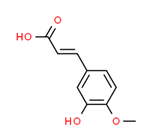 |
| Acacetin | Yes | Yes | Yes | - | Natural products | [106] |  |
| 5-Hydroxy Mebendazole | Yes | - | - | - | Pharmaceutical | [107] |  |
| Acetamiprid | - | - | - | Yes | Pesticide | [108] |  |
| Alpha-zearalenol | Yes | Yes | Yes | Yes | Natural product | [109] |  |
| Bisphenol A | Yes | Yes | - | Yes | Polycarbonate plastic | [65] |  |
| Caffeic Acid | Yes | - | Yes | - | Natural products | [110] |  |
| carbamazepine | Yes | Yes | - | Yes | Pharmaceutical | [111] |  |
| Carbendazim | Yes | - | - | - | Fungicide | [67] |  |
| Cotinine | Yes | - | - | - | Metabolite | [112] | 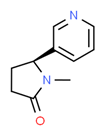 |
| Diazinon | - | Yes | - | - | Pesticide | [113] |  |
| Dibutylphthalate | Yes | Yes | Yes | Yes | Plasticizer | [114] | 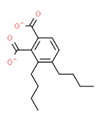 |
| Dicofol | Yes | Yes | - | - | Pesticide | [115] | 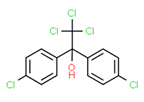 |
| Fenamiphos | Yes | Yes | - | Yes | Pesticide | [116] |  |
| Ferimzone | Yes | Yes | Yes | Yes | Pesticide | [117] |  |
| Ferutinine | Yes | Yes | Yes | Yes | Natural product | [75] |  |
| Halofenozide | Yes | Yes | - | Yes | Pesticide | [118] | 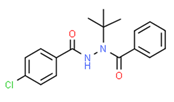 |
| Hexazinone | Yes | Yes | Yes | Yes | Pesticide | [119] | 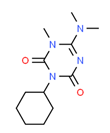 |
| Isobavachin | Yes | Yes | Yes | Yes | Natural product | [120] | 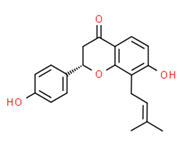 |
| Isosakuranetin | Yes | Yes | - | Yes | Natural product | [121] |  |
| Levamisole | Yes | - | - | - | Pharmaceutical | [122] |  |
| Lidocaine | Yes | - | - | - | Pharmaceutical | [123] |  |
| Nitenpyram | Yes | - | - | - | Pesticide | [124] |  |
| Phthalic acid | Yes | Yes | - | Yes | Plasticizer | [125] | 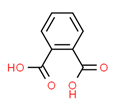 |
| Phthalic Acid Bis(2 Ethylhexyl) Ester | Yes | Yes | - | Yes | Plastic-softening agent | [126] |  |
| Pregabalin | Yes | Yes | - | - | Pharmaceutical | [85] |  |
| Salicylic acid | Yes | Yes | - | - | Pharmaceutical | [127] |  |
| Tebuconazole | Yes | Yes | Yes | Yes | Pesticide | [128] |  |
3.2.3. Drinking Water
3.2.4. Vegetables
4. Conclusions
5. Limitations and Future Work
Supplementary Materials
Author Contributions
Funding
Institutional Review Board Statement
Informed Consent Statement
Data Availability Statement
Acknowledgments
Conflicts of Interest
References
- Kidd, K.A.; Blanchfield, P.J.; Mills, K.H.; Palace, V.P.; Evans, R.E.; Lazorchak, J.M.; Flick, R.W. Collapse of a fish population after exposure to a synthetic estrogen. Proc. Natl. Acad. Sci. USA 2007, 104, 8897–8901. [Google Scholar] [CrossRef] [PubMed]
- Velicu, M.; Suri, R. Presence of steroid hormones and antibiotics in surface water of agricultural, suburban and mixed-use areas. Environ. Monit. Assess. 2009, 154, 349–359. [Google Scholar] [CrossRef] [PubMed]
- Zhang, H.; Shi, J.; Liu, X.; Zhan, X.; Dang, J.; Bo, T. Occurrence of free estrogens, conjugated estrogens, and bisphenol A in fresh livestock excreta and their removal by composting in North China. Environ. Sci. Pollut. Res. Int. 2014, 21, 9939–9947. [Google Scholar] [CrossRef] [PubMed]
- Byrns, G. The fate of xenobiotic organic compounds in wastewater treatment plants. Water Res. 2001, 35, 2523–2533. [Google Scholar] [CrossRef] [PubMed]
- Stevens, J.L.; Northcott, G.L.; Stern, G.A.; Tomy, G.T.; Jones, K.C. PAHs, PCBs, PCNs, organochlorine pesticides, synthetic musks, and polychlorinated n-alkanes in U.K. sewage sludge: Survey results and implications. Environ. Sci. Technol. 2003, 37, 462–467. [Google Scholar] [CrossRef]
- Kuch, H.M.; Ballschmiter, K. Determination of endocrine-disrupting phenolic compounds and estrogens in surface and drinking water by HRGC-(NCI)-MS in the picogram per liter range. Environ. Sci. Technol. 2001, 35, 3201–3206. [Google Scholar] [CrossRef]
- Majima, K.; Fukui, T.; Yuan, J.; Wang, G.; Matsumoto, K. Quantitative measurement of 17 beta-estradiol and estriol in river water by time-resolved fluoroimmunoassay. Anal. Sci. 2002, 18, 869–874. [Google Scholar]
- Gonsioroski, A.; Mourikes, V.; Flaws, J. Endocrine Disruptors in Water and Their Effects on the Reproductive System. Int. J. Mol. Sci. 2020, 21, 1929. [Google Scholar] [CrossRef]
- Wee, S.Y.; Aris, A.Z.; Yusoff, F.M.; Praveena, S.M. Occurrence of multiclass endocrine disrupting compounds in a drinking water supply system and associated risks. Sci. Rep. 2020, 10, 17755. [Google Scholar] [CrossRef]
- Routledge, E.J.; Sheahan, D.; Desbrow, C.; Brighty, G.C.; Waldock, M.; Sumpter, J.P. Identification of Estrogenic Chemicals in STW Effluent. 2. In Vivo Responses in Trout and Roach. Environ. Sci. Technol. 1998, 11, 1559–1565. [Google Scholar] [CrossRef]
- Adeel, M.; Song, X.; Wang, Y.; Francis, D.; Yang, Y.. Environmental impact of estrogens on human, animal and plant life: A critical review. Environ. Int. 2017, 99, 107–119. [Google Scholar] [CrossRef] [PubMed]
- Paterni, I.; Granchi, C.; Minutolo, F. Risks and benefits related to alimentary exposure to xenoestrogens. Crit. Rev. Food Sci. Nutr. 2017, 57, 3384–3404. [Google Scholar] [CrossRef] [PubMed]
- Khalil, N.; Chen, A.; Lee, M. Endocrine disruptive compounds and cardio-metabolic risk factors in children. Curr. Opin. Pharmacol. 2014, 19, 120–124. [Google Scholar] [CrossRef] [PubMed]
- Bianca, S.; Ingegnosi, C.; Ettore, G. Maternal and Paternal Risk Factors for Hypospadias. Environ. Health Perspect. 2005, 5, A296. [Google Scholar] [CrossRef]
- Ferlin, A.; Foresta, C. Testis Cancer: Genes, Environment, Hormones. Front. Endocrinol. 2014, 5, 172. [Google Scholar] [CrossRef]
- Hardell, L.; Malmqvist, N.; Ohlson, C.G.; Westberg, H.; Eriksson, M. Testicular cancer and occupational exposure to polyvinyl chloride plastics: A case-control study. Int. J. Cancer 2004, 109, 425–429. [Google Scholar] [CrossRef]
- St-Hilaire, S.; Mandal, R.; Commendador, A.; Mannel, S.; Derryberry, D. Estrogen receptor positive breast cancers and their association with environmental factors. Int. J. Health Geogr. 2011, 10, 32. [Google Scholar] [CrossRef]
- Porpora, M.G.; Resta, S.; Fuggetta, E.; Storelli, P.; Megiorni, F.; Manganaro, L.; De Felip, E. Role of environmental organochlorinated pollutants in the development of endometriosis. Clin. Exp. Obstet. Gynecol. 2013, 40, 565–567. [Google Scholar]
- Diamanti-Kandarakis, E.; Bourguignon, J.P.; Giudice, L.C.; Hauser, R.; Prins, G.S.; Soto, A.M.; Zoeller, R.T.; Gore, A.C. Endocrine-disrupting chemicals: An Endocrine Society scientific statement. Endocr. Rev. 2009, 30, 293–342. [Google Scholar] [CrossRef]
- Owen, R.; Jobling, S. Environmental science: The hidden costs of flexible fertility. Nature 2012, 485, 441. [Google Scholar] [CrossRef]
- Wise, A.; O’Brien, K.; Woodruff, T. Are oral contraceptives a significant contributor to the estrogenicity of drinking water? Environ. Sci. Technol. 2011, 45, 51–60. [Google Scholar] [CrossRef] [PubMed]
- Skakkebaek, N.E.; Rajpert-De Meyts, E.; Main, K.M. Testicular dysgenesis syndrome: An increasingly common developmental disorder with environmental aspects. Hum. Reprod. 2001, 16, 972–978. [Google Scholar] [CrossRef] [PubMed]
- Harris, H.A.; Albert, L.M.; Leathurby, Y.; Malamas, M.S.; Mewshaw, R.E.; Miller, C.P.; Kharode, Y.P.; Marzolf, J.; Komm, B.S.; Winneker, R.C.; et al. Evaluation of an estrogen receptor-beta agonist in animal models of human disease. Endocrinology 2003, 144, 4241–4249. [Google Scholar] [CrossRef] [PubMed]
- Holme, J.A.; Dybing, E. Are environmental chemicals with hormone-like properties a health problem? Tidsskr. Nor. Laegeforen. 1997, 117, 70–73. [Google Scholar]
- Mohsen, M.S. Water strategies and potential of desalination in Jordan. Desalination Strateg. South Mediterr. Ctries. 2007, 203, 27–46. [Google Scholar] [CrossRef]
- Zoller, U.; Hushan, M. The nonionic surfactant pollution profile of Israel Mediterranean Sea coastal water. Water Sci. Technol. 2001, 43, 245–250. [Google Scholar] [CrossRef] [PubMed]
- Shore, L.S.; Reichmann, O.; Shemesh, M.; Wenzel, A.; Litaor, M.I. Washout of accumulated testosterone in a watershed. Sci. Total Environ. 2004, 332, 193–202. [Google Scholar] [CrossRef]
- Barel-Cohen, K.; Shore, L.S.; Shemesh, M.; Wenzel, A.; Mueller, J.; Kronfeld-Schor, N. Monitoring of natural and synthetic hormones in a polluted river. J. Environ. Manag. 2006, 78, 16–23. [Google Scholar] [CrossRef]
- Alkhoury, W.; Ziegmann, M.; Frimmel, F.H.; Abbt-Braun, G.; Salameh, E. Water quality of the King Abdullah Canal/Jordan–impact on eutrophication and water disinfection. Toxicol. Environ. Chem. 2010, 92, 855–877. [Google Scholar] [CrossRef]
- Jamrah, A.; Ayyash, S. Greywater generation and characterization in major cities in Jordan. Jordan J. Civ. Eng. 2008, 2, 376–390. [Google Scholar]
- Al-Ansari, N.; Alibrahiem, N.; Alsaman, M.; Knutsson, S. Water supply network losses in Jordan. J. Water Resour. Prot. 2014, 6, 83–96. [Google Scholar] [CrossRef]
- Al-Kharabsheh, A. Challenges to Sustainable Water Management in Jordan. Jordan J. Earth Environ. Sci. 2020, 11, 38. [Google Scholar]
- Closas, A.; Molle, F. Groundwater Governance in the Arab World–Taking Stock and Addressing the Challenges; USAID/IWMI, 2016. [Google Scholar]
- Le, T.A.H. The YES Assay as a Tool to Analyse Endocrine Disruptors in Different Matrices in Vietnam. Doctoral Dissertation, Universitäts-und Landesbibliothek Bonn, Bonn, Germany, 2012. [Google Scholar]
- Hassannejad, M.; Alizadeh, K.; Nemati, M. Determination of 17-β-Estradiol in Water Samples Using Salting-out Assisted Liquid-liquid Extraction Followed by HPLC and Experimental Design for Optimization. Anal. Bioanal. Chem. Res. 2019, 6, 353–363. [Google Scholar]
- Beresford, N.; Baynes, A.; Kanda, R.; Mills, M.R.; Arias-Salazar, K.; Collins, T.J.; Jobling, S. Use of a Battery of Chemical and Ecotoxicological Methods for the Assessment of the Efficacy of Wastewater Treatment Processes to Remove Estrogenic Potency. J. Vis. Exp. 2016, 11, e54243. [Google Scholar] [CrossRef]
- Bistan, M.; Podgorelec, M.; Logar, R.M.; Tišler, T. Yeast Estrogen Screen Assay as a Tool for Detecting Estrogenic Activity in Water Bodies. Food Technol. Biotechnol. 2012, 50, 7. [Google Scholar]
- Soto, A.M.; Calabro, J.M.; Prechtl, N.V.; Yau, A.Y.; Orlando, E.F.; Daxenberger, A.; Kolok, A.S.; Guillette, L.J.; le Bizec, B.; Lange, I.G.; et al. Androgenic and estrogenic activity in water bodies receiving cattle feedlot effluent in Eastern Nebraska, USA. Environ. Health Perspect. 2004, 112, 346–352. [Google Scholar] [CrossRef]
- Lopez-Herguedas, N.; González-Gaya, B.; Cano, A.; Alvarez-Mora, I.; Mijangos, L.; Etxebarria, N.; Zuloaga, O.; Olivares, M.; Prieto, A. Effect-directed analysis of a hospital effluent sample using A-YES for the identification of endocrine disrupting compounds. Sci. Total Environ. 2022, 850, 157985. [Google Scholar] [CrossRef]
- Czernych, R.; Chraniuk, M.; Zagozdzon, P.; Wolska, L. Characterization of estrogenic and androgenic activity of phthalates by the XenoScreen YES/YAS in vitro assay. Environ. Toxicol. Pharmacol. 2017, 53, 95–104. [Google Scholar] [CrossRef]
- Maisa’a, W.S.; Abualhaija, M.M. An Analysis of Long Term Yearly Water Flow Trend and Its Impact on Sediment Yield in King Talal Dam. Int. J. Eng. Res. Technol. 2019, 12, 3041–3049. [Google Scholar]
- Hilal, A.H.A.; Alhaija, M.M.A. Nutrients in Water and Sediments of King Talal Dam-Jordan. Jordan J. Biol. Sci. 2010, 3, 87–100. [Google Scholar]
- Al-Mashakbeh, H.M. The influence of lithostratigraphy on the type and quality of stored water in mujib reservoir-Jordan. J. Environ. Prot. 2017, 8, 568. [Google Scholar] [CrossRef]
- Shigei, M.; Assayed, A.; Hazaymeh, A.; Dalahmeh, S.S. Pharmaceutical and antibiotic pollutant levels in wastewater and the waters of the Zarqa river, Jordan. Appl. Sci. 2021, 11, 8638. [Google Scholar] [CrossRef]
- Al-Mashagbah, A.F. Assessment of surface water quality of king abdullah canal, using physico-chemical characteristics and water quality index, Jordan. J. Water Resour. Prot. 2015, 7, 339. [Google Scholar] [CrossRef]
- Fang, H.; Tong, W.; Perkins, R.; Soto, A.M.; Prechtl, N.V.; Sheehan, D.M. Quantitative comparisons of in vitro assays for estrogenic activities. Environ. Health Perspect. 2000, 108, 723–729. [Google Scholar] [CrossRef] [PubMed]
- Nascimento, M.T.L.d.; Santos, A.D.d.O.; Cunha, D.L.d.; Felix, L.C.; Gomes, G.; Rangel, C.M.A.; Hauser-Davis, R.A.; Fonseca, E.M.d.; Bila, D.M.; Baptista Neto, J.A. Endocrine disruptors, estrogenic activity by the YES bioassay, and acute toxicity in Southeastern Brazil metropolitan surface waters. Geochim. Bras. 2022, 36, e-22005. [Google Scholar] [CrossRef]
- Yusuf, A.; O’Flynn, D.; White, B.; Holland, L.; Parle-McDermott, A.; Lawler, J.; McCloughlin, T.; Harold, D.; Huerta, B.; Regan, F. Monitoring of emerging contaminants of concern in the aquatic environment: A review of studies showing the application of effect-based measures. Anal. Methods 2021, 13, 5120–5143. [Google Scholar] [CrossRef]
- El-Naqa, A.; Al Raei, A. Assessment of Drinking Water Quality Index (WQI) in the Greater Amman Area, Jordan. Jordan J. Earth Environ. Sci. 2021, 12, 306–314. [Google Scholar]
- Miyahuna Website: Our Work. 2022. Available online: https://miyahuna.com.jo/en/page/Our-Work-29 (accessed on 10 November 2022).
- Russo, G.; Laneri, S.; Di Lorenzo, R.; Neri, I.; Dini, I.; Ciampaglia, R.; Grumetto, L. Monitoring of Pollutants Content in Bottled and Tap Drinking Water in Italy. Molecules 2022, 27, 3990. [Google Scholar] [CrossRef]
- Okpara, K.E.; Phoungthong, K.; Agbozu, I.; Edwin-Isotu, E.; Techato, K. Phthalate Esters in Tap Water, Southern Thailand: Daily Exposure and Cumulative Health Risk in Infants, Lactating Mothers, Pregnant and Nonpregnant Women. Int. J. Environ. Res. Public Health 2022, 19, 2187. [Google Scholar] [CrossRef]
- González, A.; Kroll, K.J.; Silva-Sanchez, C.; Carriquiriborde, P.; Fernandino, J.I.; Denslow, N.D.; Somoza, G. M Steroid hormones and estrogenic activity in the wastewater outfall and receiving waters of the Chascomús chained shallow lakes system (Argentina). Sci. Total Environ. 2020, 743, 140401. [Google Scholar] [CrossRef]
- Johan, L.; Persson, K.M.; Agneta, O. Glass-bottled drinking water: A time capsule to study the historic presence of hazardous chemicals using effect-based methods. Environ. Sci. Eur. 2021, 33, 1–9. [Google Scholar]
- Yazdan, M.M.S.; Kumar, R.; Leung, S.W. The Environmental and Health Impacts of Steroids and Hormones in Wastewater Effluent, as Well as Existing Removal Technologies: A Review. Ecologies 2022, 3, 206–224. [Google Scholar] [CrossRef]
- Jari, Y.; Roche, N.; Necibi, M.C.; El Hajjaji, S.; Dhiba, D.; Chehbouni, A. Emerging pollutants in moroccan wastewater: Occurrence, Impact, and removal technologies. J. Chem. 2022, 2022, 9727857. [Google Scholar] [CrossRef]
- Chiang, Y.R.; Wei, S.T.S.; Wang, P.H.; Wu, P.H.; Yu, C.P. Microbial degradation of steroid sex hormones: Implications for environmental and ecological studies. Microb. Biotechnol. 2020, 13, 926–949. [Google Scholar] [CrossRef] [PubMed]
- Abdelrahim, M.; Ariazi, E.; Kim, K.; Khan, S.; Barhoumi, R.; Burghardt, R.; Liu, S.; Hill, D.; Finnell, R.; Wlodarczyk, B.; et al. 3-Methylcholanthrene and other aryl hydrocarbon receptor agonists directly activate estrogen receptor alpha. Cancer Res. 2006, 66, 2459–2467. [Google Scholar] [CrossRef] [PubMed]
- Nakagawa, Y.; Tayama, K. Estrogenic potency of benzophenone and its metabolites in juvenile female rats. Arch. Toxicol. 2001, 75, 74–79. [Google Scholar] [CrossRef]
- Satake, K.; Yoshimoto, T.; Mukai, R.; Umeyama, K. Estrogen receptors in 7,12-dimethylbenz (a) anthracene (DMBA) induced pancreatic carcinoma in rats and in human pancreatic carcinoma. Clin. Oncol. 1982, 8, 49–54. [Google Scholar]
- Gellert, R.J. Kepone, mirex, dieldrin, and aldrin: Estrogenic activity and the induction of persistent vaginal estrus and anovulation in rats following neonatal treatment. Environ. Res. 1978, 16, 131–138. [Google Scholar] [CrossRef]
- Spencer, F.; Chi, L.; Zhu, M.X. Effect of benomyl and carbendazim on steroid and molecular mechanisms in uterine decidual growth in rats. J. Appl. Toxicol. 1996, 16, 211–214. [Google Scholar] [CrossRef]
- Majhi, P.D.; Sharma, A.; Roberts, A.L.; Daniele, E.; Majewski, A.R.; Chuong, L.M.; Black, A.L.; Vandenberg, L.N.; Schneider, S.S.; Dunphy, K.A.; et al. Effects of Benzophenone-3 and Propylparaben on Estrogen Receptor-Dependent R-Loops and DNA Damage in Breast Epithelial Cells and Mice. Environ. Health Perspect. 2020, 128, 17002. [Google Scholar] [CrossRef]
- Ertürk, N. Comparison of estrogen and betamethasone in the topical treatment of labial adhesions in prepubertal girls. Turk. J. Med. Sci. 2014, 44, 1103–1107. [Google Scholar] [CrossRef] [PubMed]
- Gao, H.; Yang, B.J.; Li, N.; Feng, L.M.; Shi, X.Y.; Zhao, W.H.; Liu, S.J. Bisphenol A and hormone-associated cancers: Current progress and perspectives. Medicine 2015, 94, e211. [Google Scholar] [CrossRef] [PubMed]
- Ashfaq, M.; Sun, Q.; Ma, C.; Rashid, A.; Li, Y.; Mulla, S.I.; Yu, C.-P. Occurrence, seasonal variation and risk evaluation of selected endocrine disrupting compounds and their transformation products in Jiulong river and estuary, China. Mar. Pollut. Bull. 2019, 145, 370–376. [Google Scholar] [CrossRef] [PubMed]
- Liu, J.; Zhang, P.; Zhao, Y.; Zhang, H. Low dose carbendazim disrupts mouse spermatogenesis might be through estrogen receptor related histone and DNA methylation. Ecotoxicol. Environ. Saf. 2019, 176, 242–249. [Google Scholar] [CrossRef]
- Javed, R.; Hanif, M.A.; Rehman, R.; Hanif, M.; Tung, B.T. Chapter 7—Caraway. In Medicinal Plants of South Asia; Elsevier: Amsterdam, The Netherlands, 2020; pp. 87–100. [Google Scholar]
- Zhao, M.; Zhang, Y.; Liu, W.; Xu, C.; Wang, L.; Gan, J. Estrogenic activity of lambda-cyhalothrin in the MCF-7 human breast carcinoma cell line. Environ. Toxicol. Chem. 2008, 27, 1194–1200. [Google Scholar] [CrossRef]
- Go, R.E.; Kim, C.W.; Choi, K.C. Effect of fenhexamid and cyprodinil on the expression of cell cycle- and metastasis-related genes via an estrogen receptor-dependent pathway in cellular and xenografted ovarian cancer models. Toxicol. Appl. Pharmacol. 2015, 289, 48–57. [Google Scholar] [CrossRef]
- Orton, F.; Rosivatz, E.; Scholze, M.; Kortenkamp, A. Widely used pesticides with previously unknown endocrine activity revealed as in vitro antiandrogens. Environ. Health Perspect. 2011, 119, 794–800. [Google Scholar] [CrossRef]
- Petit, F.; Le Goff, P.; Cravédi, J.P.; Valotaire, Y.; Pakdel, F. Two complementary bioassays for screening the estrogenic potency of xenobiotics: Recombinant yeast for trout estrogen receptor and trout hepatocyte cultures. J. Mol. Endocrinol. 1997, 19, 321–335. [Google Scholar] [CrossRef]
- Andersen, H.R.; Bonefeld-Jørgensen, E.C.; Nielsen, F.; Jarfeldt, K.; Jayatissa, M.N.; Vinggaard, A.M. Estrogenic effects in vitro and in vivo of the fungicide fenarimol. Toxicol. Lett. 2006, 163, 142–152. [Google Scholar] [CrossRef]
- Sohoni, P.; Lefevre, P.A.; Ashby, J.; Sumpter, J.P. Possible androgenic/anti-androgenic activity of the insecticide fenitrothion. J. Appl. Toxicol. 2001, 21, 173–178. [Google Scholar] [CrossRef]
- Zavatti, M.; Guida, M.; Maraldi, T.; Beretti, F.; Bertoni, L.; La Sala, G.B.; De Pol, A. Estrogen receptor signaling in the ferutinin-induced osteoblastic differentiation of human amniotic fluid stem cells. Life Sci. 2016, 164, 15–22. [Google Scholar] [CrossRef] [PubMed]
- Go, R.E.; Kim, C.W.; Jeon, S.Y.; Byun, Y.S.; Jeung, E.B.; Nam, K.H.; Choi, K.C. Fludioxonil induced the cancer growth and metastasis via altering epithelial-mesenchymal transition via an estrogen receptor-dependent pathway in cellular and xenografted breast cancer models. Environ. Toxicol. 2017, 32, 1439–1454. [Google Scholar] [CrossRef] [PubMed]
- Stonesifer, G.L., Jr.; Lowe, R.H.; Cameron, J.L.; Ganis, F.M. Conversion of hydrocortisone to estrogen in carcinoma of the breast after oophorectomy and adrenalectomy. Ann. Surg. 1973, 178, 563–564. [Google Scholar] [CrossRef] [PubMed]
- Jin, C.; Zhang, R.; Fu, Z.; Jin, Y. Maternal exposure to imazalil disrupts the endocrine system in F(1) generation mice. Mol. Cell. Endocrinol. 2019, 486, 105–112. [Google Scholar] [CrossRef] [PubMed]
- Wang, J.; Pan, L.; Wu, S.; Lu, L.; Xu, Y.; Zhu, Y.; Guo, M.; Zhuang, S. Recent Advances on Endocrine Disrupting Effects of UV Filters. Int. J. Environ. Res. Public Health 2016, 13, 782. [Google Scholar] [CrossRef]
- Alsadik, A.; Athamneh, K.; Yousef, A.F.; Shah, I.; Ashraf, S.S. Efficient Degradation of 2-Mercaptobenzothiazole and Other Emerging Pollutants by Recombinant Bacterial Dye-Decolorizing Peroxidases. Biomolecules 2021, 11, 656. [Google Scholar] [CrossRef] [PubMed]
- Mathias, F.T.; Romano, R.M.; Sleiman, H.K.; de Oliveira, C.A.; Romano, M.A. Herbicide metolachlor causes changes in reproductive endocrinology of male wistar rats. ISRN Toxicol. 2012, 2012, 130846. [Google Scholar] [CrossRef]
- Matsumoto, H.; Adachi, S.; Suzuki, Y. Estrogenic activity of ultraviolet absorbers and the related compounds. Yakugaku Zasshi 2005, 125, 643–652. [Google Scholar] [CrossRef]
- Matsumoto, H.; Adachi, S.; Suzuki, Y. Risk Assessment of Ethylhexyl Dimethyl PABA in Cosmetics. Toxicol. Res. 2019, 35, 131–136. [Google Scholar]
- Kim, S.S.; Lee, R.D.; Lim, K.J.; Kwack, S.J.; Rhee, G.S.; Seok, J.H.; Lee, G.S.; An, B.S.; Jeung, E.B.; Park, K.L. Potential estrogenic and antiandrogenic effects of permethrin in rats. J. Reprod. Dev. 2005, 51, 201–210. [Google Scholar] [CrossRef]
- Taha, S.H.N.; Zaghloul, H.S.; Ali, A.; Rashed, L.A.; Sabry, R.M.; Gaballah, I.F. Molecular and hormonal changes caused by long-term use of high dose pregabalin on testicular tissue: The role of p38 MAPK, oxidative stress and apoptosis. Mol. Biol. Rep. 2020, 47, 8523–8533. [Google Scholar] [CrossRef] [PubMed]
- Hofmeister, M.V.; Bonefeld-Jørgensen, E.C. Effects of the pesticides prochloraz and methiocarb on human estrogen receptor α and β mRNA levels analyzed by on-line RT-PCR. Toxicol. Vitr. 2004, 18, 427–433. [Google Scholar] [CrossRef] [PubMed]
- Bonefeld-Jorgensen, E.C.; Grünfeld, H.T.; Gjermandsen, I.M. Effect of pesticides on estrogen receptor transactivation in vitro: A comparison of stable transfected MVLN and transient transfected MCF-7 cells. Mol. Cell. Endocrinol. 2005, 244, 20–30. [Google Scholar] [CrossRef] [PubMed]
- Gu, C.J.; Cheng, J.; Zhang, B.; Yang, S.L.; Xie, F.; Sun, J.S.; Huang, L.Q.; Yu, J.J.; Li, M.Q. Protopanaxadiol and metformin synergistically inhibit estrogen-mediated proliferation and anti-autophagy effects in endometrial cancer cells. Am. J. Transl. Res. 2017, 9, 4071–4082. [Google Scholar]
- Medjakovic, S.; Zoechling, A.; Gerster, P.; Ivanova, M.M.; Teng, Y.; Klinge, C.M.; Schildberger, B.; Gartner, M.; Jungbauer, A. Effect of nonpersistent pesticides on estrogen receptor, androgen receptor, and aryl hydrocarbon receptor. Environ. Toxicol. 2014, 29, 1201–1216. [Google Scholar] [CrossRef]
- Kim, S.-H.; Bae, J.-W.; Kim, D.-H.; Jeong, D.-J.; Ha, J.J.; Yi, J.K.; Kwon, W.-S. Detrimental effects of temephos on male fertility: An in vitro study on a mouse model. Reprod. Toxicol. 2020, 96, 150–155. [Google Scholar] [CrossRef]
- Kim, S.S.; Kwack, S.J.; Lee, R.D.; Lim, K.J.; Rhee, G.S.; Seok, J.H.; Kim, B.H.; Won, Y.H.; Lee, G.S.; Jeung, E.B.; et al. Assessment of estrogenic and androgenic activities of tetramethrin in vitro and in vivo assays. J. Toxicol. Environ. Health A 2005, 68, 2277–2289. [Google Scholar]
- Richardson, S.D.; Postigo, C. Drinking water disinfection by-products. In Emerging Organic Contaminants and Human Health; Springer: Berlin/Heidelberg, Germany, 2011; pp. 93–137. [Google Scholar]
- Li, X.-F.; Mitch, W.A. Drinking Water Disinfection Byproducts (DBPs) and Human Health Effects: Multidisciplinary Challenges and Opportunities. Environ. Sci. Technol. 2018, 52, 1681–1689. [Google Scholar] [CrossRef]
- Tiedeken, E.J.; Tahar, A.; McHugh, B.; Rowan, N.J. Monitoring, sources, receptors, and control measures for three European Union watch list substances of emerging concern in receiving waters—A 20year systematic review. Sci. Total Environ. 2017, 574, 1140–1163. [Google Scholar] [CrossRef]
- Moreira, I.S.; Murgolo, S.; Mascolo, G.; Castro, P.M.L. Biodegradation and Metabolic Pathway of 17β-Estradiol by Rhodococcus sp. ED55. Int. J. Mol. Sci. 2022, 23, 6181. [Google Scholar] [CrossRef]
- Mrayyan, B.; Hussein, I. Integrated assessment of the control of wastewater pollution in Zarqa Governate, Jordan. Int. J. Environ. Pollut. 2004, 22, 580–596. [Google Scholar] [CrossRef]
- Argolo, A.d.S.; Gomes, G.; Bila, D.M. Insights into total estrogenic activity in a sewage-impacted urban stream assessed via ER transcriptional activation assay: Distribution between particulate and dissolved phases. Ecotoxicol. Environ. Saf. 2021, 208, 111574. [Google Scholar] [CrossRef] [PubMed]
- Simon, E.; Duffek, A.; Stahl, C.; Frey, M.; Scheurer, M.; Tuerk, J.; Gehrmann, L.; Könemann, S.; Swart, K.; Behnisch, P. Biological effect and chemical monitoring of Watch List substances in European surface waters: Steroidal estrogens and diclofenac–Effect-based methods for monitoring frameworks. Environ. Int. 2022, 159, 107033. [Google Scholar] [CrossRef] [PubMed]
- Raeburn, R.H.; Rockett, L.S.; Rumsby, P.C. Chapter 20—Considerations of Endocrine Disrupters in Water. In Endocrine Disruption and Human Health, 2nd ed.; Darbre, P.D., Ed.; Academic Press: Cambridge, MA, USA, 2022; pp. 415–444. [Google Scholar]
- Al-Omari, A.; Al-Houri, Z.; Al-Weshah, R. Impact of the As Samra wastewater treatment plant upgrade on the water quality (COD, electrical conductivity, TP, TN) of the Zarqa River. Water Sci. Technol. 2013, 67, 1455–1464. [Google Scholar] [CrossRef]
- Tang, Z.; Liu, Z.-h.; Wang, H.; Dang, Z.; Liu, Y. A review of 17α-ethynylestradiol (EE2) in surface water across 32 countries: Sources, concentrations, and potential estrogenic effects. J. Environ. Manag. 2021, 292, 112804. [Google Scholar] [CrossRef] [PubMed]
- Al Khateeb, W. Plants genotoxicity as pollution bioindicator in Jordan using comet assay. Physiol. Mol. Biol. Plants 2018, 24, 89–97. [Google Scholar] [CrossRef]
- Fandi, K.G.; Qudsieh, I.Y.; Muyibi, S.A.; Massadeh, M. Water pollution status assessment of King Talal Dam, Jordan. Adv. Environ. Biol. 2009, 3, 92–100. [Google Scholar]
- Echeverri-Jaramillo, G.; Jaramillo-Colorado, B.; Sabater-Marco, C.; Castillo-López, M. Cytotoxic and estrogenic activity of chlorpyrifos and its metabolite 3,5,6-trichloro-2-pyridinol. Study of marine yeasts as potential toxicity indicators. Ecotoxicology 2021, 30, 104–117. [Google Scholar] [CrossRef]
- Belkaid, A.; Čuperlović-Culf, M.; Touaibia, M.; Ouellette, R.J.; Surette, M.E. Metabolic Effect of Estrogen Receptor Agonists on Breast Cancer Cells in the Presence or Absence of Carbonic Anhydrase Inhibitors. Metabolites 2016, 6, 16. [Google Scholar] [CrossRef]
- Ta, N.; Walle, T. Aromatase inhibition by bioavailable methylated flavones. J. Steroid Biochem. Mol. Biol. 2007, 107, 127–129. [Google Scholar] [CrossRef] [PubMed]
- Pantziarka, P.; Bouche, G.; Meheus, L.; Sukhatme, V.; Sukhatme, V.P. Repurposing Drugs in Oncology (ReDO)-mebendazole as an anti-cancer agent. Ecancermedicalscience 2014, 8, 443. [Google Scholar] [CrossRef] [PubMed]
- Halawa, E.; Ryad, L.; El-Shenawy, N.S.; Al-Eisa, R.A.; El-Hak, H.N.G. Evaluation of acetamiprid and azoxystrobin residues and their hormonal disrupting effects on male rats using liquid chromatography-tandem mass spectrometry. PLoS ONE 2021, 16, e0259383. [Google Scholar] [CrossRef] [PubMed]
- Khosrokhavar, R.; Rahimifard, N.; Shoeibi, S.; Hamedani, M.P.; Hosseini, M.J. Effects of zearalenone and alpha-Zearalenol in comparison with Raloxifene on T47D cells. Toxicol. Mech. Methods 2009, 19, 246–250. [Google Scholar] [CrossRef] [PubMed]
- Rosendahl, A.H.; Perks, C.M.; Zeng, L.; Markkula, A.; Simonsson, M.; Rose, C.; Ingvar, C.; Holly, J.M.; Jernström, H. Caffeine and Caffeic Acid Inhibit Growth and Modify Estrogen Receptor and Insulin-like Growth Factor I Receptor Levels in Human Breast Cancer. Clin. Cancer Res. 2015, 21, 1877–1887. [Google Scholar] [CrossRef]
- Vlasov, P.N.; Karlov, V.A.; Kushlinskiĭ, N.E. The pharmacological and hormonal effects of carbamazepine and valproic acid in the treatment of reproductive age women with epilepsy. Zhurnal Nevrol. I Psikhiatrii Im. SS Korsakova 2001, 101, 26–30. [Google Scholar]
- d’Adesky, N.D.; de Rivero Vaccari, J.P.; Bhattacharya, P.; Schatz, M.; Perez-Pinzon, M.A.; Bramlett, H.M.; Raval, A.P. Nicotine Alters Estrogen Receptor-Beta-Regulated Inflammasome Activity and Exacerbates Ischemic Brain Damage in Female Rats. Int. J. Mol. Sci. 2018, 19, 1330. [Google Scholar] [CrossRef]
- Medithi, S.; Kasa, Y.D.; Jee, B.; Venkaiah, K.; Jonnalagadda, P.R. Alterations in reproductive hormone levels among farm women and their children occupationally exposed to organophosphate pesticides. Women Health 2022, 62, 454–464. [Google Scholar] [CrossRef]
- Wójtowicz, A.K.; Szychowski, K.A.; Wnuk, A.; Kajta, M. Dibutyl Phthalate (DBP)-Induced Apoptosis and Neurotoxicity are Mediated via the Aryl Hydrocarbon Receptor (AhR) but not by Estrogen Receptor Alpha (ERα), Estrogen Receptor Beta (ERβ), or Peroxisome Proliferator-Activated Receptor Gamma (PPARγ) in Mouse Cortical Neurons. Neurotox. Res. 2017, 31, 77–89. [Google Scholar]
- Hoekstra, P.F.; Burnison, B.K.; Garrison, A.W.; Neheli, T.; Muir, D.C. Estrogenic activity of dicofol with the human estrogen receptor: Isomer- and enantiomer-specific implications. Chemosphere 2006, 64, 174–177. [Google Scholar] [CrossRef]
- Yamada, K.; Terasaki, M.; Makino, M. Estrogenic Activity of Alkyl(thio)phenols and 4,4’-thiodiphenol Formed from Degradation of Commercial Insecticides. J. Health Sci. 2011, 57, 134–141. [Google Scholar] [CrossRef]
- Kojima, H.; Katsura, E.; Takeuchi, S.; Niiyama, K.; Kobayashi, K. Screening for estrogen and androgen receptor activities in 200 pesticides by in vitro reporter gene assays using Chinese hamster ovary cells. Environ. Health Perspect. 2004, 112, 524–531. [Google Scholar] [CrossRef] [PubMed]
- Daas, O.; Scaps, P.; Bouzerna, N.; Descamps, M. Effects of two ecdysteroid analogs (RH-0345 and RH-2485) on the total growth of eupolybothrus nudicornis (myriapoda, chilopoda). Vie Milieu/Life Environ. 2007, 57, 39–43. [Google Scholar]
- Vandenberg, L.N.; Colborn, T.; Hayes, T.B.; Heindel, J.J.; Jacobs, D.R., Jr.; Lee, D.H.; Shioda, T.; Soto, A.M.; vom Saal, F.S.; Welshons, W.V.; et al. Hormones and endocrine-disrupting chemicals: Low-dose effects and nonmonotonic dose responses. Endocr. Rev. 2012, 33, 378–455. [Google Scholar] [CrossRef]
- Dong, X.; Fan, Y.; Yu, L.; Hu, Y. Synthesis of four natural prenylflavonoids and their estrogen-like activities. Arch. Pharm. 2007, 340, 372–376. [Google Scholar] [CrossRef] [PubMed]
- Galluzzo, P.; Ascenzi, P.; Bulzomi, P.; Marino, M. The nutritional flavanone naringenin triggers antiestrogenic effects by regulating estrogen receptor alpha-palmitoylation. Endocrinology 2008, 149, 2567–2575. [Google Scholar] [CrossRef] [PubMed]
- Liu, L.L.; Liu, L.; Liu, H.H.; Ren, S.S.; Dou, C.Y.; Cheng, P.P.; Wang, C.L.; Wang, L.N.; Chen, X.L.; Zhang, H.; et al. Levamisole suppresses adipogenesis of aplastic anaemia-derived bone marrow mesenchymal stem cells through ZFP36L1-PPARGC1B axis. J. Cell. Mol. Med. 2018, 22, 4496–4506. [Google Scholar] [CrossRef] [PubMed]
- Zhou, D.; Wang, L.; Cui, Q.; Iftikhar, R.; Xia, Y.; Xu, P. Repositioning Lidocaine as an Anticancer Drug: The Role beyond Anesthesia. Front. Cell Dev. Biol. 2020, 8, 565. [Google Scholar] [CrossRef]
- Mesnage, R.; Biserni, M.; Genkova, D.; Wesolowski, L.; Antoniou, M.N. Evaluation of neonicotinoid insecticides for oestrogenic, thyroidogenic and adipogenic activity reveals imidacloprid causes lipid accumulation. J. Appl. Toxicol. 2018, 38, 1483–1491. [Google Scholar] [CrossRef]
- Pavan, B.; Biondi, C.; Ferretti, M.E.; Lunghi, L.; Paganetto, G. Phthalic acid mimics 17beta-estradiol actions in WISH cells. Toxicol. Lett. 2001, 118, 157–164. [Google Scholar] [CrossRef]
- Cheon, Y.P. Di-(2-ethylhexyl) Phthalate (DEHP) and Uterine Histological Characteristics. Dev. Reprod. 2020, 24, 1–17. [Google Scholar] [CrossRef]
- Dündar, Y.; Özatik, Y.; Özatik, O.; Ergin, V.; Önkol, T.; Menevşe, A.; Erol, K.; Sahin, M.F. Synthesis and biological evaluation of the salicylamide and salicylic acid derivatives as anti-estrogen agents. Med. Chem. 2012, 8, 481–490. [Google Scholar] [CrossRef]
- Li, S.; Sun, Q.; Wu, Q.; Gui, W.; Zhu, G.; Schlenk, D. Endocrine disrupting effects of tebuconazole on different life stages of zebrafish (Danio rerio). Environ. Pollut. 2019, 249, 1049–1059. [Google Scholar] [CrossRef] [PubMed]
- Ren, Y.; Zheng, J.; Wang, H. Transiently gene-modulated cell reporter for ultrasensitive detection of estrogen-like compounds in tap water. Chemosphere 2022, 289, 133161. [Google Scholar] [CrossRef] [PubMed]
- Jones, R.R.; Stavreva, D.A.; Weyer, P.J.; Varticovski, L.; Inoue-Choi, M.; Medgyesi, D.N.; Chavis, N.; Graubard, B.I.; Cain, T.; Wichman, M. Pilot study of global endocrine disrupting activity in Iowa public drinking water utilities using cell-based assays. Sci. Total Environ. 2020, 714, 136317. [Google Scholar] [CrossRef] [PubMed]
- Wagner, M.; Oehlmann, J. Endocrine disruptors in bottled mineral water: Estrogenic activity in the E-Screen. J. Steroid Biochem. Mol. Biol. 2011, 127, 128–135. [Google Scholar] [CrossRef]
- Pironti, C.; Ricciardi, M.; Proto, A.; Bianco, P.M.; Montano, L.; Motta, O. Endocrine-disrupting compounds: An overview on their occurrence in the aquatic environment and human exposure. Water 2021, 13, 1347. [Google Scholar] [CrossRef]
- Kumawat, M.; Sharma, P.; Pal, N.; James, M.M.; Verma, V.; Tiwari, R.R.; Shubham, S.; Sarma, D.K.; Kumar, M. Occurrence and seasonal disparity of emerging endocrine disrupting chemicals in a drinking water supply system and associated health risk. Sci. Rep. 2022, 12, 9252. [Google Scholar] [CrossRef]
- Tue, N.M.; Matsukami, H.; Tuyen, L.H.; Suzuki, G.; Viet, P.H.; Sudaryanto, A.; Subramanian, A.; Tanabe, S.; Kunisue, T. Estrogenic, androgenic, and glucocorticoid activities and major causative compounds in river waters from three Asian countries. Environ. Sci. Pollut. Res. 2022, 1–10. [Google Scholar] [CrossRef]
- Yu, M.; Lavonen, E.; Oskarsson, A.; Lundqvist, J. Removal of oxidative stress and genotoxic activities during drinking water production by ozonation and granular activated carbon filtration. Environ. Sci. Eur. 2021, 33, 124. [Google Scholar] [CrossRef]
- Fekadu, S.; Alemayehu, E.; Dewil, R.; Van der Bruggen, B. Pharmaceuticals in freshwater aquatic environments: A comparison of the African and European challenge. Sci. Total Environ. 2019, 654, 324–337. [Google Scholar] [CrossRef]
- Ronderos-Lara, J.G.; Saldarriaga-Noreña, H.; Murillo-Tovar, M.A.; Alvarez, L.; Vergara-Sánchez, J.; Barba, V.; Guerrero-Alvarez, J.A. Distribution and Estrogenic Risk of Alkylphenolic Compounds, Hormones and Drugs Contained in Water and Natural Surface Sediments, Morelos, Mexico. Separations 2022, 9, 19. [Google Scholar] [CrossRef]
- Huang, C.; Zhou, W.; Bian, C.; Wang, L.; Li, Y.; Li, B. Degradation and Pathways of Carvone in Soil and Water. Molecules 2022, 27, 2415. [Google Scholar] [CrossRef] [PubMed]
- Hartmans, K.J.; Diepenhorst, P.; Bakker, W.; Gorris, L.G.M. The use of carvone in agriculture: Sprout suppression of potatoes and antifungal activity against potato tuber and other plant diseases. Ind. Crops Prod. 1995, 4, 3–13. [Google Scholar] [CrossRef]
- Whittaker, M.H.; Gebhart, A.M.; Miller, T.C.; Hammer, F. Human health risk assessment of 2-mercaptobenzothiazole in drinking water. Toxicol. Ind. Health 2004, 20, 149–163. [Google Scholar] [CrossRef] [PubMed]
- EFSA Scientific Committee. Scientific Opinion on the safety assessment of carvone, considering all sources of exposure. EFSA J. 2014, 12, 3806. [Google Scholar] [CrossRef]
- Toth, C. Pregabalin: Latest safety evidence and clinical implications for the management of neuropathic pain. Ther. Adv. Drug Saf. 2014, 5, 38–56. [Google Scholar] [CrossRef] [PubMed]
- Wilkinson, J.L.; Boxall, A.B.A.; Kolpin, D.W.; Leung, K.M.Y.; Lai, R.W.S.; Galbán-Malagón, C.; Adell, A.D.; Mondon, J.; Metian, M.; Marchant, R.A. Pharmaceutical pollution of the world’s rivers. Proc. Natl. Acad. Sci. USA 2022, 119, e2113947119. [Google Scholar] [CrossRef] [PubMed]
- King, A.C.F.; Giorio, C.; Wolff, E.; Thomas, E.; Roverso, M.; Schwikowski, M.; Tapparo, A.; Bogialli, S.; Kalberer, M. Direct Injection Liquid Chromatography High-Resolution Mass Spectrometry for Determination of Primary and Secondary Terrestrial and Marine Biomarkers in Ice Cores. Anal. Chem. 2019, 91, 5051–5057. [Google Scholar] [CrossRef]
- Datel, J.V.; Hrabankova, A. Pharmaceuticals load in the svihov water reservoir (Czech Republic) and impacts on quality of treated drinking water. Water 2020, 12, 1387. [Google Scholar] [CrossRef]
- Lu, J.; Wu, J.; Stoffella, P.J.; Wilson, P.C. Analysis of bisphenol A, nonylphenol, and natural estrogens in vegetables and fruits using gas chromatography–tandem mass spectrometry. J. Agric. Food Chem. 2013, 61, 84–89. [Google Scholar] [CrossRef]
- Lecomte, S.; Demay, F.; Ferrière, F.; Pakdel, F. Phytochemicals Targeting Estrogen Receptors: Beneficial Rather Than Adverse Effects? Int. J. Mol. Sci. 2017, 18, 1381. [Google Scholar] [CrossRef] [PubMed]
- Ikeda, K.; Arao, Y.; Otsuka, H.; Nomoto, S.; Horiguchi, H.; Kato, S.; Kayama, F. Terpenoids Found in the Umbelliferae Family Act as Agonists/Antagonists for ERα and ERβ: Differential Transcription Activity between Ferutinine-Liganded ERα and ERβ. Biochem. Biophys. Res. Commun. 2002, 291, 354–360. [Google Scholar] [CrossRef] [PubMed]
- Aloshoush, A. Medicinal Plants used in Traditional Herbal Medicine in the Fifa Village/Southern Jordan. Int. J. Med. Plants Nat. Prod. (IJMPNP) 2020, 6, 5–8. [Google Scholar]
- Yamamoto, H.; Watanabe, M.; Katsuki, S.; Nakamura, Y.; Moriguchi, S.; Sekizawa, J. Preliminary ecological risk assessment of butylparaben and benzylparaben -2. Fate and partitioning in aquatic environments. Environ. Sci. 2007, 14, 97–105. [Google Scholar] [PubMed]
- Markit, I.H.S. Plasticizers. Chemical Economics Handbook; HIS Markit Ltd.: London, UK, 2018. [Google Scholar]
- Yan, Y.; Zhu, F.; Zhu, C.; Chen, Z.; Liu, S.; Wang, C.; Gu, C. Dibutyl phthalate release from polyvinyl chloride microplastics: Influence of plastic properties and environmental factors. Water Res. 2021, 204, 117597. [Google Scholar] [CrossRef]
- Sedha, S.; Lee, H.; Singh, S.; Kumar, S.; Jain, S.; Ahmad, A.; Bin Jardan, Y.A.; Sonwal, S.; Shukla, S.; Simal-Gandara, J.; et al. Reproductive toxic potential of phthalate compounds—State of art review. Pharmacol. Res. 2021, 167, 105536. [Google Scholar] [CrossRef]
- Torres Acosta, J.A.; Michlmayr, H.; Shams, M.; Schweiger, W.; Wiesenberger, G.; Mitterbauer, R.; Werner, U.; Merz, D.; Hauser, M.-T.; Hametner, C. Zearalenone and ß-zearalenol but not their glucosides inhibit heat shock protein 90 ATPase activity. Front. Pharmacol. 2019, 10, 1160. [Google Scholar] [CrossRef]
- Falkauskas, R.; Bakutis, B.; Jovaišienė, J.; Vaičiulienė, G.; Gerulis, G.; Kerzienė, S.; Jacevičienė, I.; Jacevičius, E.; Baliukonienė, V. Zearalenone and Its Metabolites in Blood Serum, Urine, and Milk of Dairy Cows. Animals 2022, 12, 1651. [Google Scholar] [CrossRef]
- Meucci, V.; Soldani, G.; Razzuoli, E.; Saggese, G.; Massart, F. Mycoestrogen pollution of Italian infant food. J. Pediatr. 2011, 159, 278–283. [Google Scholar] [CrossRef]
- Wang, L.; Zhang, Q.; Yan, Z.; Tan, Y.; Zhu, R.; Yu, D.; Yang, H.; Wu, A. Occurrence and quantitative risk assessment of twelve mycotoxins in eggs and chicken tissues in China. Toxins 2018, 10, 477. [Google Scholar] [CrossRef]
- Mwihia, E.W.; Lyche, J.L.; Mbuthia, P.G.; Ivanova, L.; Uhlig, S.; Gathumbi, J.K.; Maina, J.G.; Eshitera, E.E.; Eriksen, G.S. Co-Occurrence and levels of mycotoxins in fish feeds in Kenya. Toxins 2020, 12, 627. [Google Scholar] [CrossRef] [PubMed]
- Keller, L.; Abrunhosa, L.; Keller, K.; Rosa, C.A.; Cavaglieri, L.; Venâncio, A. Zearalenone and Its Derivatives α-Zearalenol and β-Zearalenol Decontamination by Saccharomyces cerevisiae Strains Isolated from Bovine Forage. Toxins 2015, 7, 3297–3308. [Google Scholar] [CrossRef] [PubMed]
- Ito, H.C.; Shiraishi, H.; Nakagawa, M.; Takamura, N. Combined impact of pesticides and other environmental stressors on animal diversity in irrigation ponds. PloS ONE 2020, 15, e0229052. [Google Scholar] [CrossRef] [PubMed]
- Viegas, S.; Assunção, R.; Martins, C.; Caetano, L.A.; Viegas, C. Portuguese Groundwater Contamination with Fungicides: The Need for Action. 2021. Available online: https://repositorio.ipl.pt/handle/10400.21/13622 (accessed on 4 November 2022).
- Del Puerto, O.; Gonçalves, N.P.F.; Medana, C.; Prevot, A.B.; Roslev, P. Attenuation of toxicity and occurrence of degradation products of the fungicide tebuconazole after combined vacuum UV and UVC treatment of drinking water. Environ. Sci. Pollut. Res. 2022, 29, 58312–58325. [Google Scholar] [CrossRef]
- Albers, C.N.; Bollmann, U.E.; Badawi, N.; Johnsen, A.R. Leaching of 1, 2, 4-triazole from commercial barley seeds coated with tebuconazole and prothioconazole. Chemosphere 2022, 286, 131819. [Google Scholar] [CrossRef]
- Bending, G.D.; Rodríguez-Cruz, M.S.; Lincoln, S.D. Fungicide impacts on microbial communities in soils with contrasting management histories. Chemosphere 2007, 69, 82–88. [Google Scholar] [CrossRef]
- Da Silva, J.P.; Da Silva, A.M.; Khmelinskii, I.V.; Martinho, J.M.G.; Ferreira, L.F.V. Photophysics and photochemistry of azole fungicides: Triadimefon and triadimenol. J. Photochem. Photobiol. A Chem. 2001, 142, 31–37. [Google Scholar] [CrossRef]
- Wang, Y.; Ning, X.; Li, G.; Sang, N. New insights into potential estrogen agonistic activity of triazole fungicides and coupled metabolic disturbance. J. Hazard. Mater. 2022, 424, 127479. [Google Scholar] [CrossRef]
- Lu, P.; Li, Q.; Liu, H.; Feng, Z.; Yan, X.; Hong, Q.; Li, S. Biodegradation of chlorpyrifos and 3, 5, 6-trichloro-2-pyridinol by Cupriavidus sp. DT-1. Bioresour. Technol. 2013, 127, 337–342. [Google Scholar] [CrossRef]
- Wang, L.; Wu, Y.; Zhang, W.; Kannan, K. Characteristic Profiles of Urinary p-Hydroxybenzoic Acid and its Esters (Parabens) in Children and Adults from the United States and China. Environ. Sci. Technol. 2013, 47, 2069–2076. [Google Scholar] [CrossRef]
- Alawi, I.N.T.M.A.; Abu, R.H.S.R.M. Pesticide Residues in Commonly Consumed Fruits and Vegetables in Jordan and Their Associated Health Risk Assessments. Jordan J. Chem. (JJC) 2019, 14, 69–80. [Google Scholar]
- Al-Nasir, F.M.; Jiries, A.G.; Al-Rabadi, G.J.; Alu’datt, M.H.; Tranchant, C.C.; Al-Dalain, S.A.; Alrabadi, N.; Madanat, O.Y.; Al-Dmour, R.S. Determination of pesticide residues in selected citrus fruits and vegetables cultivated in the Jordan Valley. LWT 2020, 123, 109005. [Google Scholar] [CrossRef]
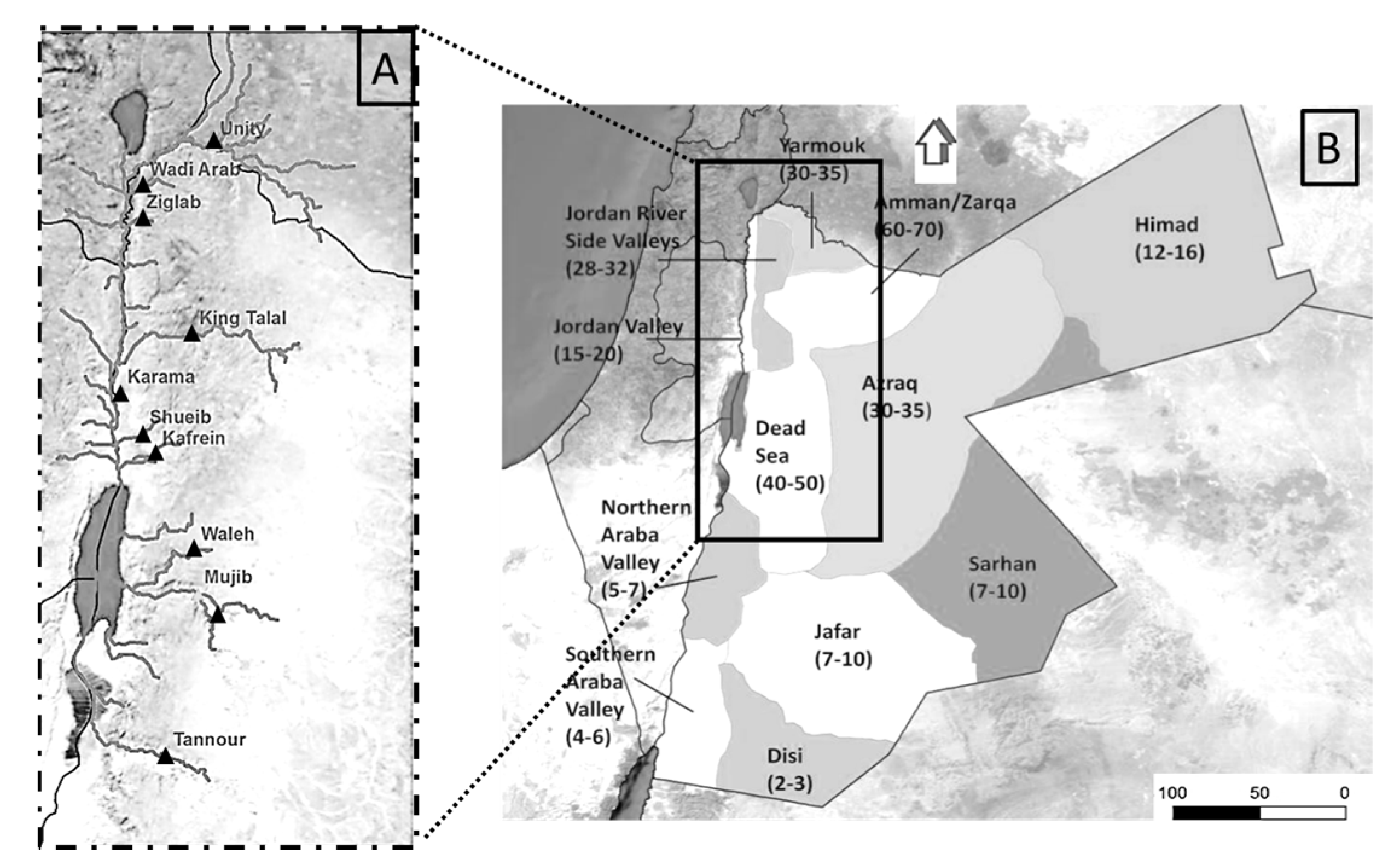


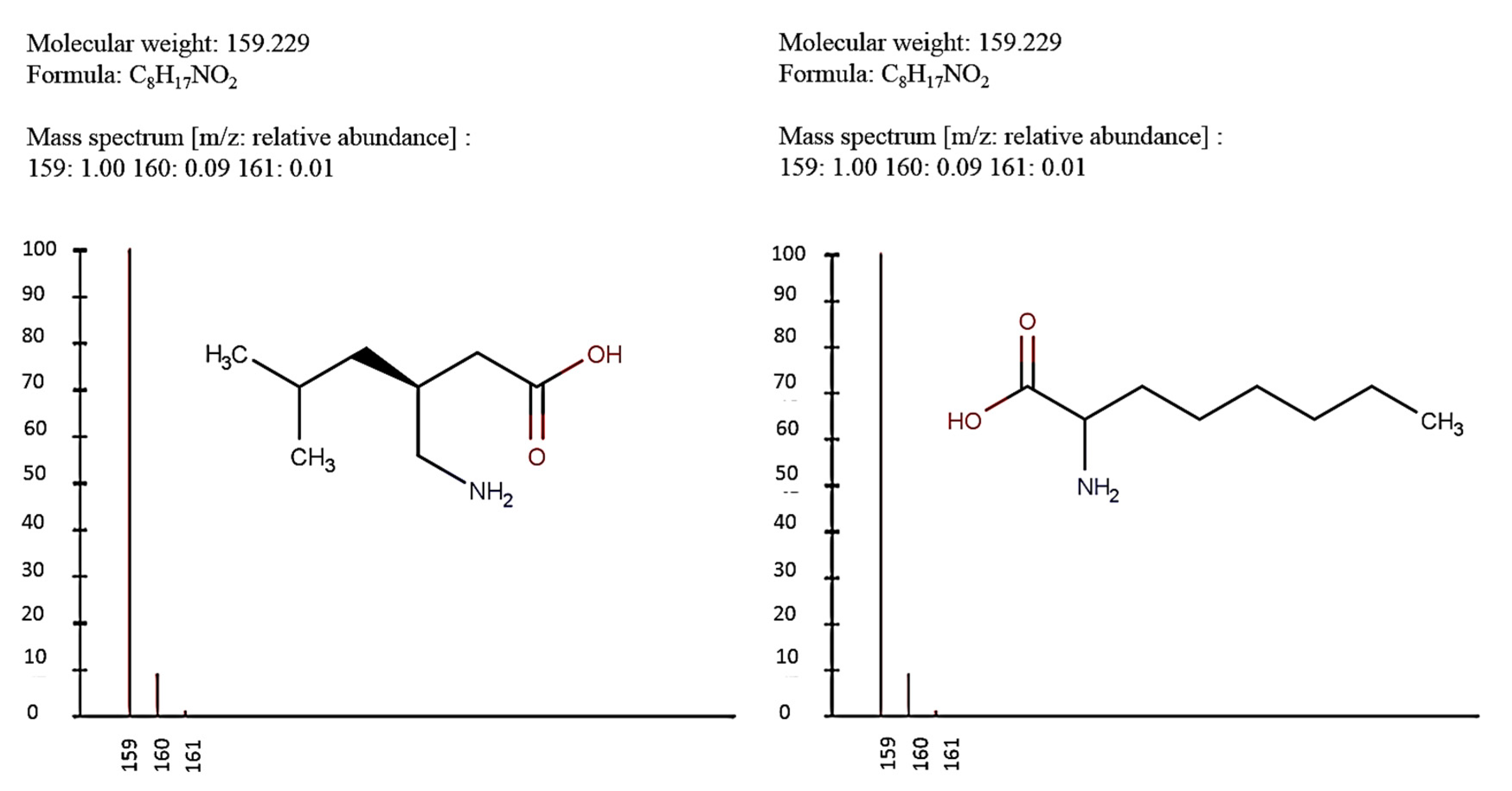
| Name | Samples Collection by |
|---|---|
| King Talal Dam | MWI 1 |
| Almujeb Dam | MWI |
| As-Samra Wastewater Treatment Plant | MWI |
| King Abdullah Canal: Dair Alla | MWI |
| Tap water | Researchers |
| Drinking water | Researchers |
| Name | Total 17β-Estradiol Equivalents (ng/L) |
|---|---|
| King Talal Dam | 2.9 ± 1.2 |
| Almujeb Dam | ND |
| As-Samra Wastewater Treatment Plant | 9.5 ± 5 |
| King Abdullah Canal: Dair Alla | 2.5 ±1.5 |
| Tap water | 1.4 ± 0.9 |
| Drinking water | ND |
| Expected Compound | Irbid | Amman | Origin 3 | Ref. 2 | Chemical Structure 1 |
|---|---|---|---|---|---|
| 3-Methylcholanthrene | Yes | Yes | Pesticide/fungicide | [58] |  |
| 4-Hydroxybenzophenone | Yes | Yes | Intermediate of clomiphene | [59] |  |
| 7,12-Dimethyl-benz(a)anthracene | Yes | Yes | Incomplete combustion of gasoline and coal | [60] | 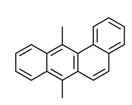 |
| Aldrin | Yes | Yes | Banned insecticide | [61] | 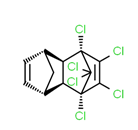 |
| Benomyl | Yes | Yes | Fungicide | [62] | 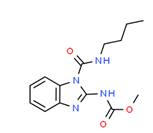 |
| Benzophenone-3 | - | Yes | Sunscreen agent | [63] | 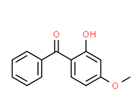 |
| Betamethasone valerate | Yes | Yes | Corticosteroid | [64] |  |
| Bisphenol A | Yes | Yes | Manufacturing of various plastics | [65] |  |
| Carbanilide | Yes | Yes | Pesticide | [66] | 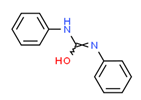 |
| Carbendazim | Yes | Yes | Fungicide | [67] |  |
| Carvone | Yes | Yes | Insect repellent | [68] |  |
| Cyhalothrin | Yes | Yes | Pesticide | [69] |  |
| Cyprodinil | Yes | Yes | Fungicide | [70] |  |
| Dimethomorph | Yes | - | Fungicide | [71] |  |
| Dodemorph II | Yes | Yes | Pesticide | [72] | 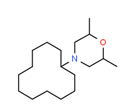 |
| Fenarimol | Yes | Yes | Fungicide | [73] | 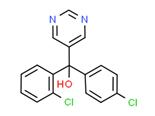 |
| Fenitrothion | Yes | Yes | Pesticide | [74] |  |
| Ferutinin | - | Yes | Natural product | [75] |  |
| Fludioxonil | Yes | Yes | Fungicide | [76] | 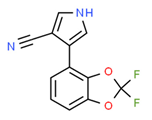 |
| Hydrocortisone | Yes | Yes | Hormone cortisol | [77] | 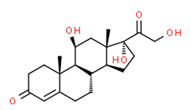 |
| Imazalil | Yes | - | Pesticide | [78] | 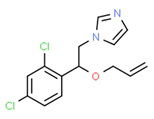 |
| Isopentyl-4-methoxycinnamate | - | Yes | Sunscreen product | [79] | 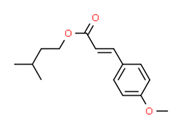 |
| 2-Mercaptobenzothiazole | - | Yes | Pesticide | [80] |  |
| Metolachlor | Yes | Yes | Herbicide | [81] | 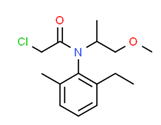 |
| Octocrylene | - | Yes | Sunscreen product | [82] | 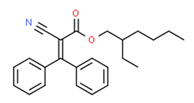 |
| Para amino-benzoic acid | - | Yes | Sunscreen product | [83] |  |
| Permethrin | Yes | Yes | Insecticide | [84] |  |
| Pregabalin | Yes | Yes | Pharmaceuticals | [85] |  |
| Prochloraz | Yes | Yes | Fungicide | [86] | 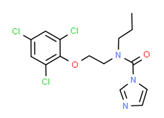 |
| Propamocarb | Yes | Yes | Fungicide | [87] |  |
| Protopanaxadiol | Yes | Yes | Natural product | [88] |  |
| Pyrimethanil | Yes | Yes | Fungicide | [89] |  |
| Temephos | Yes | Yes | Organophosphate larvicide | [90] |  |
| Tetramethrin | Yes | Yes | Insecticide | [91] |  |
| Expected Compound | Origin 3 | Ref. 2 | Chemical Structure 1 |
|---|---|---|---|
| Carvone | Insect repellent | [68] | 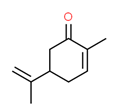 |
| 2-Mercaptobenzothiazole | Pesticide | [80] |  |
| Pregabalin | Pharmaceutical | [85] |  |
| Expected Compound | Origin 3 | Ref. 2 | Chemical Structure 1 |
|---|---|---|---|
| Ferutinin | Natural product | [75] | 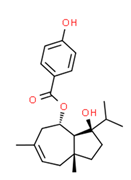 |
| Butylparaben | Sunscreens | [168] |  |
| Dibutylphthalate | Plasticizer | [114] |  |
| Alpha-zearalenol | Natural product | [109] |  |
| Ferimzone | Fungicide | [117] | 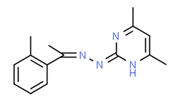 |
| Tebuconazole | Fungicide | [128] |  |
| 3 5 6-Trichloro-2-pyridinol | Pesticide | [104] |  |
Disclaimer/Publisher’s Note: The statements, opinions and data contained in all publications are solely those of the individual author(s) and contributor(s) and not of MDPI and/or the editor(s). MDPI and/or the editor(s) disclaim responsibility for any injury to people or property resulting from any ideas, methods, instructions or products referred to in the content. |
© 2023 by the authors. Licensee MDPI, Basel, Switzerland. This article is an open access article distributed under the terms and conditions of the Creative Commons Attribution (CC BY) license (https://creativecommons.org/licenses/by/4.0/).
Share and Cite
Akkam, Y.; Omari, D.; Alhmoud, H.; Alajmi, M.; Akkam, N.; Aljarrah, I. Assessment of Xenoestrogens in Jordanian Water System: Activity and Identification. Toxics 2023, 11, 63. https://doi.org/10.3390/toxics11010063
Akkam Y, Omari D, Alhmoud H, Alajmi M, Akkam N, Aljarrah I. Assessment of Xenoestrogens in Jordanian Water System: Activity and Identification. Toxics. 2023; 11(1):63. https://doi.org/10.3390/toxics11010063
Chicago/Turabian StyleAkkam, Yazan, Derar Omari, Hassan Alhmoud, Mohammad Alajmi, Nosaibah Akkam, and Islam Aljarrah. 2023. "Assessment of Xenoestrogens in Jordanian Water System: Activity and Identification" Toxics 11, no. 1: 63. https://doi.org/10.3390/toxics11010063
APA StyleAkkam, Y., Omari, D., Alhmoud, H., Alajmi, M., Akkam, N., & Aljarrah, I. (2023). Assessment of Xenoestrogens in Jordanian Water System: Activity and Identification. Toxics, 11(1), 63. https://doi.org/10.3390/toxics11010063






